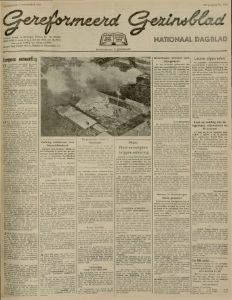About the day » Thursday November 7, 1963Calender converter
November 8, 1963 
 November 6, 1963
November 6, 1963
Born on Thursday November 7, 1963
- Raymond Edward van 't Veldt, Bussum († 1986)
- Nancy T. VERNIERS († 2011)
- Pieter Darrel Mantel, Wainfleet, Ontario, Canada
- Patrick SOILLE, Hasselt († 2021)
- Bernadette Maria Johanna Beljaars, Dordrecht, Zuid-Holland, Nederland
- Corné Pennings, Bergen op Zoom, Noord-Brabant, Nederland († 2023)
- Maurits Brands
- Infant Todd ? *****, Los Alamos, Los Alamos, New Mexico, Verenigde Staten († 1963)
- Hendrika Sjoerdina Johanna van Otterloo († 1963)
- Sjouke van Seijen, Brielle, Zuid-Holland, Nederland († 2017)
Died on Thursday November 7, 1963
- Albertus Jansen (77), Elst, Gelderland, Nederland
- Christina Dina van den Tol (76), Zierikzee
- Botte Douwes Westendorp (49), Chatham, Chatham-Kent Division, Ontario, Canada
- Albert Hutten (81), Enschede, Nederland
- Arjen Frans Folkersma (90), 's-Gravenhage, Zuid-Holland, Nederland
- Adriana Luijk (86)
- Alice P. Eggebrecht (95), Coleman, Coleman County, Texas
- Abraham Gerardus Kahlé (62), Amsterdam, Noord-Holland, Nederland
- Auke Fritskes Hepkema (90), Heerenveen, Gem. Heerenveen, Friesland, Nederland
- Albert Jan Slag (67), Enter
Source: Delpher (KB | national library) Newspapers from November 7, 1963 at Delpher
- Nieuwsblad van het Noorden
- Friese koerier : onafhankelijk dagblad voor Friesland en aangrenzende gebieden
- Amigoe di Curacao : weekblad voor de Curacaosche eilanden
- Nieuw Suriname : Surinaams nieuws- en advertentieblad
- Het vrije volk : democratisch-socialistisch dagblad
- Gereformeerd gezinsblad / hoofdred. P. Jongeling
- Limburgsch dagblad
- De waarheid
- Leeuwarder courant : hoofdblad van Friesland
- De Tijd De Maasbode
Born on November 7
- 1961 » Orlando Mercado, American baseball player and coach
- 1962 » Dirk Shafer, American model, actor, and director († 2015)
- 1962 » Tracie Savage, American actress and journalist
- 1963 » John Barnes, Jamaican-English footballer and manager
- 1963 » Sam Graves, American farmer and politician
- 1964 » Bonnie St. John, American skier and scholar
- 1964 » Dana Plato, American actress († 1999)
- 1964 » Liam Ó Maonlaí, Irish keyboard player and songwriter
- 1964 » Philip Hollobone, English soldier and politician
- 1964 » Troy Beyer, American actress, director, and screenwriter
Died on November 7
- 1959 » Victor McLaglen, English-American boxer and actor (b. 1883)
- 1962 » Eleanor Roosevelt, American humanitarian and politician, 39th First Lady of the United States (b. 1884)
- 1964 » Hans von Euler-Chelpin, German-Swedish biochemist and academic, Nobel Prize laureate (b. 1863)
- 1966 » Rube Bressler, American baseball player (b. 1894)
- 1967 » John Nance Garner, American lawyer and politician, 32nd Vice President of the United States (b. 1868)
- 1968 » Alexander Gelfond, Russian mathematician, cryptographer, and academic (b. 1906)
- 1968 » Gordon Coventry, Australian footballer and coach (b. 1901)
- 1974 » Eric Linklater, Welsh-Scottish author and academic (b. 1899)
- 1975 » Piero Dusio, Italian footballer, businessman and race car driver (b. 1899)
- 1978 » Jivraj Narayan Mehta, Indian surgeon and politician, 6th Chief Minister of Gujarat (b. 1887)
Names that were popular for boys in 1963
- Johannes
- Jan
- Maria
- Cornelis
- Peter
- Hendrik
- John
- Robert
- Willem
- Petrus
- Gerardus
- Paul
- Pieter
- Wilhelmus
- Johan
- Antonius
Names that were popular for girls in 1963
- Maria
- Johanna
- Elisabeth
- Cornelia
- Wilhelmina
- Anna
- Marie
- Catharina
- Adriana
- Petronella
- Ann
- Hendrika
- Yvonne
- Monique
- Margaretha
- Ingrid
Source: Wikipedia Historical events 1963
- Koningin Juliana (Huis van Oranje-Nassau) was from September 4, 1948 till April 30, 1980 sovereign of the Netherlands (also known as Koninkrijk der Nederlanden)
- In The Netherlands , there was from May 19, 1959 to July 24, 1964 the cabinet De Quay, with Prof. dr. J.E. de Quay (KVP) as prime minister.
- In The Netherlands , there was from July 24, 1963 to April 14, 1965 the cabinet Marijnen, with Mr. V.G.M. Marijnen (KVP) as prime minister.
- The Netherlands had about 11.9 million citizens.
- May 2 » Berthold Seliger launches a rocket with three stages and a maximum flight altitude of more than 100 kilometres near Cuxhaven. It is the only sounding rocket developed in Germany.
- July 26 » An earthquake in Skopje, Yugoslavia (present-day North Macedonia) leaves 1,100 dead.
- October 10 » France cedes control of the Bizerte naval base to Tunisia.
- November 22 » U.S. President John F. Kennedy is assassinated and Texas Governor John Connally is seriously wounded by Lee Harvey Oswald, who also kills Dallas Police officer J. D. Tippit after fleeing the scene. U.S Vice President Lyndon B. Johnson is sworn in as the 36th President of the United States afterwards.
- November 22 » William Clay Ford Sr. buys the Detroit Lions for $4.5 million.
- December 10 » An assassination attempt on the British High Commissioner in Aden kills two people and wounds dozens more.
The weather on Thursday November 7, 1963
The temperature on November 7, 1963 was between 6.7 °C and 10.8 °C and averaged 9.2 °C. There was 21.4 mm of rain during 5.8 hours. There was 0.8 hours of sunshine (9%). The partly or heavily clouded was. The average windspeed was 3 Bft (moderate breeze) and was prevailing from the south-southwest.
Source: KNMI
Source: KNMI
